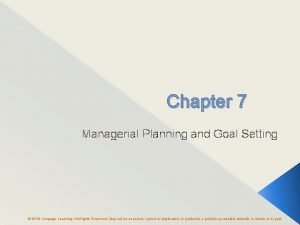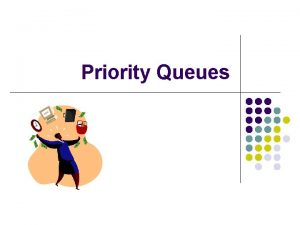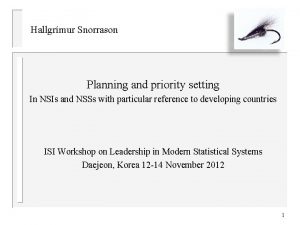Discussion on the Planning and priority setting with













- Slides: 13

Discussion on the Planning and priority setting with a view to user needs, balancing resources Tun Naing, Director-General, CSO, Myanmar ISI Workshop on Leadership in Modern Statistical Systems Daejeon, Korea 12 November 2012

Background: The Speaker • Tun Naing, born in 1960, Myanmar • Bachelor of Economic (Statistics) in 1980 Honours Degree (Statistics) in 1981 Diploma in Computer Science in 1995 Master in Business Administration in 2004 • 28 years service in Central Statistical Organization under the Ministry of National Planning and Economic Development • Director-General of CSO, Myanmar from 2009 to Present 2

Practices or experience in Myanmar • CSO(Myanmar) faces larger demands for statistics than before from government, private institutions, research institutions, NGO as well as INGO and international organizations such as UN organizations, ASEAN, ADB, World Bank, IMF, etc. • The common known uses of statistics in Myanmar are in (a) policy formulation and analysis, (b) project/program cost benefit and/or impact assessment, (c) research support and technical analysis, (d) surveillance and monitoring, and (e) public information.

Practices or experience in Myanmar • We also produces and/or publish regular outputs that make significant use of statistics such as the Statistical Yearbook and several statistical publications, etc. • Types of statistics usually demanded by: – Need for surveys as HIES, Business Register, Census – Requests for a high level of detail and data on the calculation for Food security • Ad hoc demand from government for special services such as agricultural surveys for tropical zone • Demand from international organisations for special surveys Population Census, Labor Force Survey, IHLCA, MICS, etc.

How to establish priorities? • CSO and statistcal agencies in Myanmar are setting up priorities by requirements of our own becasue we don’t have NSDS at present. (But we already discussed about lack of NSDS in Myanmar and we hope that we can draw our NSDS very soon by the support of donar countries and donar agencies. ) • For Myanmar Statistical System, prioritization has to be done with proper aggrement among CSO and line ministries, users in consultation with development partners and international doners.

How to establish priorities? • Basic statistical requirements such as national accounts , trade statistics, financial statistics should be given high priority and socioeconomic indicators developments should also be included as one of the priorities. • CSO is currently holding meetings regularly with data producers in order to balance between the users and the different types of statistics needs such as in the area of economic, social and environment

Practices or experience under donor driven demand – donor coordination • In Myanmar, our statistical system is decentralised one, so almost all ministries have planning or statistics unit to produce their statistics • So, collaboration and cooperation is the major task for our CSO • In July, we have already discussed with international development partners by presenting results out of our discussions among line ministries - which were - to revise the existing statistical law and to develop national strategy for development of statistics as most priority area.

• We may have different donors for different areas in very near future and we always make sure of – the donor agendas should be in line with our national economic/strategic plans and their plans for implementation – the use of international definitions, classifications and practices – involving national staffs in all actitivties so that they can communications within and among departments also we can get expertise and experience too. – cooperating with international agencies on demand priorities – fulfilling the donor’s requirements but should also be in line with our requirements, targets and priorities.

Resource constraints But we have some constraints, • Normally, our Government provide budgets to conduct surveys and statistical activities. And also we might seek funding for the giant task like Population Census. • In addition to funding, we have human resource constraints and technological knowhow. That’s why, capacity building is most essential for us too 9

The role of multi-year planning, of strategic plans (NSDSs), implementation plans • Without NSDS- no multi year work plan for us at the moment • But we already discussed about lack of NSDS in Myanmar and we hope that we can draw our NSDS very soon by the support of donar countries and donar agencies. • So, multi year work plan for us will be happened in near future

• We draw annual work plan for our CSO before 3 months ahead of budget year (our budget year is start from 1 st April to 31 st March) • Review for the implementation of our plan on quarterly basic

• It is recognized that this initiative entails a long process, commitment and investment by all of us, and should be implemented with due consideration of the varying levels of statistical development, technology and resources among national statistical offices and data producing institutions

Thank you for your attention 13
 Burman's priority list gives priority to
Burman's priority list gives priority to Priority mail vs priority mail express
Priority mail vs priority mail express Conclusion of distillation
Conclusion of distillation Characteristics of goal setting
Characteristics of goal setting Chapter 8 planning and goal-setting
Chapter 8 planning and goal-setting Goal setting and action planning chart example
Goal setting and action planning chart example Understanding jim crow (setting the setting)
Understanding jim crow (setting the setting) N planning
N planning Short, medium and long term planning in education
Short, medium and long term planning in education Types of language planning slideshare
Types of language planning slideshare Hát kết hợp bộ gõ cơ thể
Hát kết hợp bộ gõ cơ thể Bổ thể
Bổ thể Tỉ lệ cơ thể trẻ em
Tỉ lệ cơ thể trẻ em
























